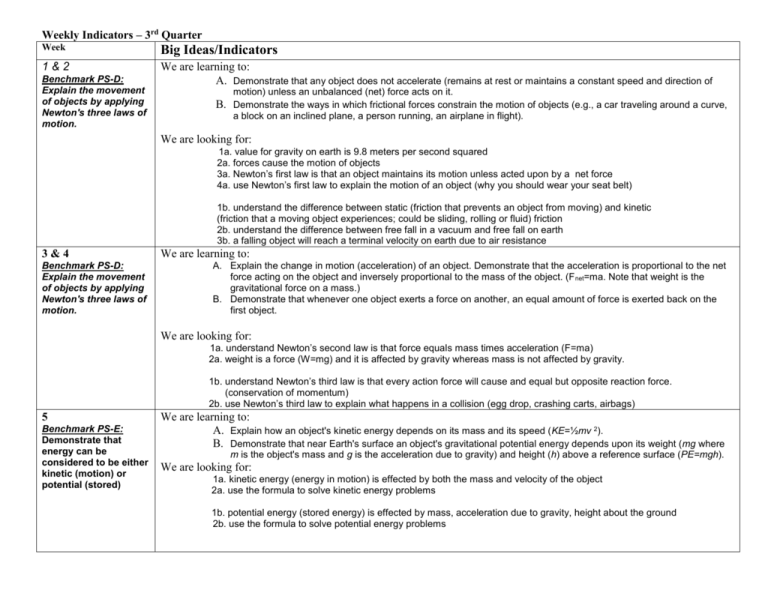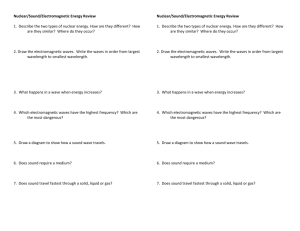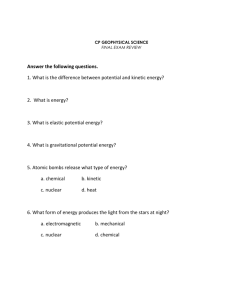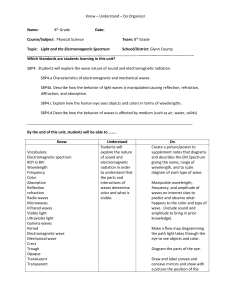Weekly Indicators – 3rd Quarter
advertisement

Weekly Indicators – 3rd Quarter Week Big Ideas/Indicators 1&2 We are learning to: A. Demonstrate that any object does not accelerate (remains at rest or maintains a constant speed and direction of Benchmark PS-D: Explain the movement of objects by applying Newton's three laws of motion. motion) unless an unbalanced (net) force acts on it. B. Demonstrate the ways in which frictional forces constrain the motion of objects (e.g., a car traveling around a curve, a block on an inclined plane, a person running, an airplane in flight). We are looking for: 1a. value for gravity on earth is 9.8 meters per second squared 2a. forces cause the motion of objects 3a. Newton’s first law is that an object maintains its motion unless acted upon by a net force 4a. use Newton’s first law to explain the motion of an object (why you should wear your seat belt) 1b. understand the difference between static (friction that prevents an object from moving) and kinetic (friction that a moving object experiences; could be sliding, rolling or fluid) friction 2b. understand the difference between free fall in a vacuum and free fall on earth 3b. a falling object will reach a terminal velocity on earth due to air resistance 3&4 Benchmark PS-D: Explain the movement of objects by applying Newton's three laws of motion. We are learning to: A. Explain the change in motion (acceleration) of an object. Demonstrate that the acceleration is proportional to the net force acting on the object and inversely proportional to the mass of the object. (F net=ma. Note that weight is the gravitational force on a mass.) B. Demonstrate that whenever one object exerts a force on another, an equal amount of force is exerted back on the first object. We are looking for: 1a. understand Newton’s second law is that force equals mass times acceleration (F=ma) 2a. weight is a force (W=mg) and it is affected by gravity whereas mass is not affected by gravity. 1b. understand Newton’s third law is that every action force will cause and equal but opposite reaction force. (conservation of momentum) 2b. use Newton’s third law to explain what happens in a collision (egg drop, crashing carts, airbags) 5 Benchmark PS-E: Demonstrate that energy can be considered to be either kinetic (motion) or potential (stored) We are learning to: A. Explain how an object's kinetic energy depends on its mass and its speed (KE=½mv 2). B. Demonstrate that near Earth's surface an object's gravitational potential energy depends upon its weight (mg where m is the object's mass and g is the acceleration due to gravity) and height (h) above a reference surface (PE=mgh). We are looking for: 1a. kinetic energy (energy in motion) is effected by both the mass and velocity of the object 2a. use the formula to solve kinetic energy problems 1b. potential energy (stored energy) is effected by mass, acceleration due to gravity, height about the ground 2b. use the formula to solve potential energy problems 6 Benchmark PS-F: Explain how energy may change form or be redistributed but the total quantity of energy is conserved We are learning to: A. Trace the transformations of energy within a system (e.g., chemical to electrical to mechanical) and recognize that energy is conserved. Show that these transformations involve the release of some thermal energy. B. Demonstrate that thermal energy can be transferred by conduction, convection or radiation (e.g., through materials by the collision of particles, moving air masses or across empty space by forms of electromagnetic radiation). We are looking for: 1a. understand the law of conservation of energy (energy can be transferred to different forms, but the total amount of energy remains the same) 2a. recognize the different forms of energy (potential, kinetic, chemical, electrical, mechanical and thermal) 3a identify the transfer of energy from one form to another 1b. understand that conduction (transfer between objects by direct contact), convection (movement of energy due to differences in density) and/or radiation (transfer of energy by electromagnetic waves) are three way thermal energy can be transferred 7 Benchmark PS-G: Demonstrate that waves (e.g., sound, seismic, water and light) have energy and waves can transfer energy when they interact with matter. . We are learning to: A. Demonstrate that electromagnetic radiation is a form of energy. Recognize that light acts as a wave. Show that visible B. C. light is a part of the electromagnetic spectrum (e.g., radio waves, microwaves, infrared, visible light, ultraviolet, Xrays, and gamma rays). Show how the properties of a wave depend on the properties of the medium through which it travels. Recognize that electromagnetic waves can be transferred without a medium. Describe how waves can superimpose on one another when propagated in the same medium. Analyze conditions in which waves can bend around corners, reflect off surfaces, are absorbed by materials they enter, and change direction and speed when entering a different material. We are looking for: 1a. a wave is a disturbance that transfers energy from one point to another 2a. identify and describe the properties of waves (wavelength, frequency, amplitude, trough, crest, wave speed, period) 3a. electromagnetic spectrum is organized by frequency and wavelength 1b. electromagnetic waves do not require a medium (matter), whereas mechanical waves do require a medium 2b. speed and direction of mechanical waves are affected by the medium that they encounter/travel through 3b. recognize a change in property when given a visual image/graph/chart 1c. destructive interference is when two waves interact and the resultant wave has a smaller amplitude 2c. constructive interference is when two waves interact and the resultant wave has a larger amplitude 3c. Doppler effect is a change in wavelength and frequency of a wave emitted from a moving object (realative to the observer) 4c. Define and illustrate reflection, refraction, diffraction 5c. apply the various characteristics of waves to a real life situation 8&9 Benchmark PS-F: Explain how energy may change form or be redistributed but the total quantity of energy is conserved. We are learning to: A. Describe radioactive substances as unstable nuclei that undergo random spontaneous nuclear decay emitting particles and/or high-energy wavelike radiation. B. Summarize how nuclear reactions convert a small amount of matter into a large amount of energy. (Fission involves the splitting of a large nucleus into smaller nuclei; fusion is the joining of two small nuclei into a larger nucleus at extremely high energies.) We are looking for: 1a. alpha/beta particles and gamma waves are types of radiation that are emitted from an unstable nucleus (when an imbalance of protons to neutrons exist in the nucleus) 2a. radioactive decay is the emission of alpha or beta particles or gamma rays in a spontaneous nuclear reaction 1b. distinguish between fission and fusion reactions (Fission involves the splitting of a large nucleus into smaller nuclei; Fusion is the joining of two small nuclei into a larger nucleus at extremely high energies.) 2b. during both fission and fusion small amount of matter is converted to a large amount of energy 3b. fusion releases more energy than fission 4b. fission occurs in nuclear power plants 5b. advantages and disadvantages of nuclear power (Science and technology)








